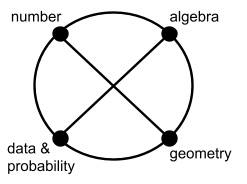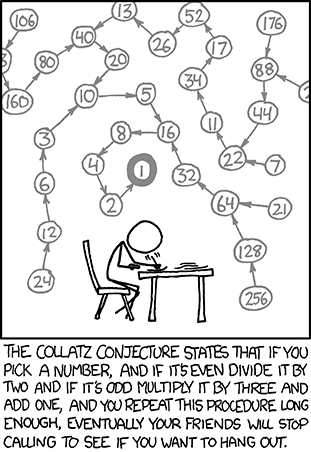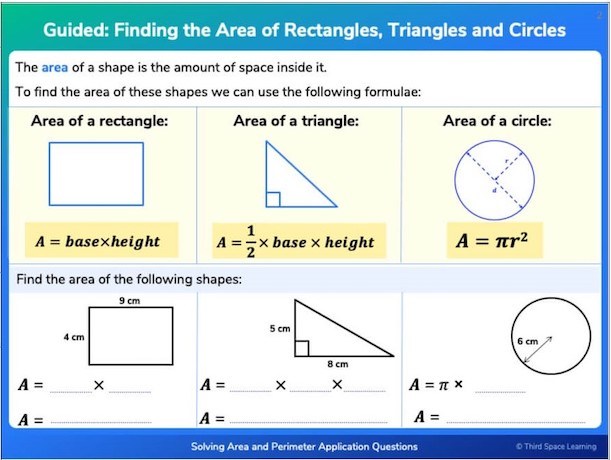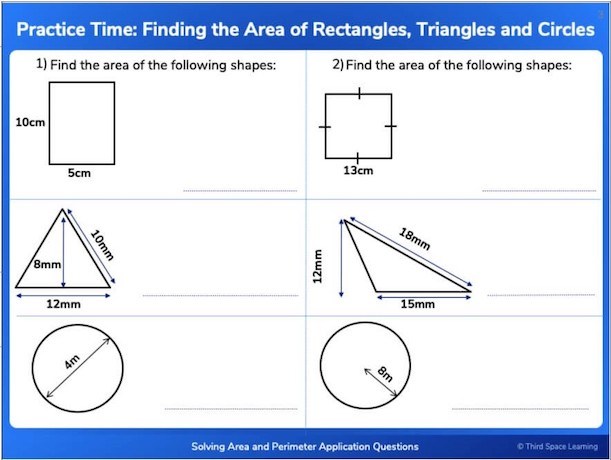Math Problems In Middle School: How To Make Yours Fun, Engaging, And Curriculum-Focused
Here, we look at how to plan for successful problem solving lessons with a range of tried and tested middle school math problems that are fun, engaging and curriculum-focused.
The notion of creating original math problems can strike fear deep into the heart of the uninitiated teacher. For some, simply delivering a lesson featuring untried problems is anxiety invoking.
Lessons based solely around problem solving activities need planning, and when doing this for the first time, it may seem like you are devising a strategic military operation with your lesson plan resembling the tactical objectives of a dawn raid. However, it doesn’t have to be like this; math is FUN (that’s why we teach it).
The art of teaching math strategies for problem solving in middle school, and the associated planning, is to focus on harnessing a particular mathematical strand. Ultimately, your problem solving lessons need to be targeting the skills that are necessary to make learners successful in the future.
As the teacher, your knowledge of math and the problems to be encountered will feed back into the planning so that the learning attributes gathered during problem solving can feed forward into exam success for the students.
How to teach problem solving
Understanding how to get students to solve problems (especially those unfamiliar, thought-provoking, and often slightly perplexing word problems) can be usefully reduced to getting students to consider just two questions…
- “What do I know?”
- “What do I need?”
These two questions are useful for us as educators, too (think data driven planning), but here, we are going to explore how to use them to drive forward our students’ ability and desire to find some solutions.
How to link problem solving to the curriculum
Your first task is to think carefully about which strand of math you want the problem to originate from. All strands of math are intrinsically linked, but if you’ve recently worked through an algebra unit, focus your math problem there.
Students can call upon skills from other strands, but their immediate thinking should be related to recent learnings or you will swiftly trigger their cognitive overload.
Don’t force a topic or real life context to fit a strand of math; consider the skills you want students to draw upon, and think about which sorts of numeracy questions would use those skills.

How to structure a problem solving session
Any problem solving session should commence with a hook; this could be a starter related to the problem at hand or a contextual discussion about why the problem is interesting.
Once you have devised a problem, attempt it yourself; this will show you what resources you need, and also the general thought processes and pitfalls your students are going to face.
It’s often a good idea to base your activities around topics that you know very well, and ones that you are confident your students have the relevant skills to be successful. Feel free to delay a particular lesson you have an idea for until you are comfortable with the subject matter.
Do some research and practice; this should be enjoyable because math is FUN. You’ll learn lots of new things, and become an even better teacher in the process.
Curriculum math problems
To get you started, below are some suggestions of the types of math problems and approaches you can take in each of the main math curriculum areas. You will clearly need to adjust your approach, and perhaps provide more or less differentiation and support at each stage depending on the age group you are teaching.
But with the right support, you’ll be amazed how far students will get trying to answer these math questions if they feel sufficiently motivated.
Number and place value math problems
Number theory is exciting. We know that, but our students don’t always, and it’s never too soon to introduce them to it. The plethora of conjectures, although fiendishly difficult to prove, are mostly based on concepts met in middle school.
Number problem example: Collatz conjecture
One of my “go to” examples of this would be the Collatz Conjecture. If you’re not familiar with this problem, I suggest looking it up; there are numerous great resources available suitable for all levels. The premise is quite simple…
- Start with any whole number:
- If the number is even, half it
- If the number is odd, triple it and then add one
- Take your answer, then repeat step 1 (i.e., either half it or triple it and add one).
- Continue until you think you have seen a pattern

The scope for the directions you can take in a lesson by using this problem and trying it out with smaller and larger numbers is enormous.
A well structured discussion with quality targeted questioning will conjure the ideas of mathematical algorithms, sequences, and patterns, through to the trickier concept of evidence versus proof.
Students can understand the problem easily. It’s straightforward to differentiate for ability and resource development is relatively minimal.
Watch the look on your students’ faces when you tell them that after so many years since its formulation, the Collatz Conjecture still has unclaimed prize money for a proof.
This instills the idea that even professional mathematicians struggle at times, and that problem solving is about investigating and building a toolkit of mathematical strategies.
Geometry math problems
Problem solving lessons focused on geometry and measurement lend themselves to practical activities; grab the colored paper, scissors, and glue, and then construct solutions.
This is where math can meet other disciplines, whether it’s engineering, art, architecture or even sport science. The reasons I do this are multiple:
- It demonstrates how applicable math is to EVERYTHING.
- It teaches students that math goes beyond the exercise book. Math is a way of thinking and is not “just about doing equations.”
- It allows students to be creative in math, which accesses more parts of the brain, and can give many students those magical lightbulb moments.
Geometry problem example: Packing boxes
A great idea for a very practical problem solving lesson would be looking at how objects pack into boxes.
This could be done using concrete resources such as tennis balls in various sized boxes, but with planning could involve also converting the problem to two dimensions, using circles with different shape mats to investigate layout configurations.
Students can then be encouraged to compare how the 2D and 3D are dealt with. For teachers wishing to brush up on the theory behind this type of work, we would need to look at the differences between geometry and topology.


Data handling and probability math problems
Data handling and probability are far more contemporary than the other strands we teach in school, so I would let the problem solving reflect this; choose very modern problems to focus on. In terms of the real world aspect, data and probability have huge implications regarding human actions.
This indicates that a good hook for the students is to have them use their knowledge of data and probability to solve a human problem.
Think about issues that are big in the news or that are prevalent in other subjects. There are great activities that can be created from issues involving the climate and environment.
A well written brief could not only boost the students’ mathematical problem solving skills, but could also lead to the solution of wider problems with the school or local area.
Data handling problem example: Recycling around the school
Why not get your students to solve the school’s recycling problems using math? Ask your students to analyze the locations and number of waste bins and recycling bins around the school building.
Automatically, this allows for rehearsal of the concepts from the data handling cycle, but also provides raw data for other problem solving activities linked to the overarching theme.
Students could be asked to consider the probability that upon leaving a cafeteria with food, they will pass a trash can of the necessary type before arriving at their next class (while following a direct route).
The scope here is huge, as the problem solving process includes use of estimation, modeling and measurement (of distance and time).
Algebra math problems
Designing problem solving lessons based around algebra may seem scary, but we are not setting out to prove Fermat’s Last Theorem. Start with the basics; building and using expressions.
You could use shapes made from paper, denoting side lengths with variables; as new shapes are created, students use the variables to determine linear expressions for perimeter and quadratic expressions for area (if they have met those concepts).
What we are looking for is any activity that allows students to use algebra to generalize.
We now come back to those important questions I mentioned:
“What do I know?” and “What do I need to know?”
Algebra problem example: Definitions and representations using algebra
When it comes to problem solving with algebra, students should build a “tool kit.” I usually begin by asking how we define an even number, an odd number; how do we represent this using algebra?
Then, move on to a square number, one more than a cube number, etc. Students can record their results and create a dictionary of algebraic phrases. Later on, we can use these to look at whether the square of an odd number is always odd, or why the square of an even number is a multiple of four.
Students can use these terms to create and manipulate a variety of polynomial expressions through addition and subtraction. They can go on to form and solve equations through inverse operations and even explore decimal and fractional terms.
These investigations can use simple or more complex numbers and be tailored to the abilities of your class.
How to lead a problem solving lesson step by step
For any math problem, but particularly in your lessons specifically focused on problem solving, students need to be coaxed into realizing how much they know about the problem already; combining this with what they need as an outcome should create a journey that contains the steps of a solution.
I’ll use an example to illustrate this.
Problem solving example: Waring’s prime number conjecture
Waring’s prime number conjecture states that every odd number (excluding 1) is a prime or the sum of three primes.
Your students need to know certain things in order to look at this:
- The definition of an odd number
- What a prime number is
Ideally, your starter activity will include some assessment for learning (for more on these see this article on teaching strategies) and a discussion to bring these ideas to the forefront of your students’ minds.
Save mentioning that this is a named conjecture until the end of the lesson.
A possible line of inquiry could be
“Which odd numbers less than 50 can be written as the sum of three primes?”
Depending on your class, you may need a more open question, or you may need to scaffold the problem into steps. Using sentence stems can help students justify their reasoning if they are struggling.
Ultimately, as long as students are encouraged to consider what they know about the problem already, and what their objective is, they will be able to actively engage in the problem solving process.
If you’ve taken my advice, you will have already attempted this problem; you know which numbers are tricky and which numbers have several solutions.
By the way, have you worked out why some numbers have a unique three prime sum and why some don’t? Maybe you should investigate this problem; remember math is FUN.
If, during an activity, you are asked if/why/how something works and you don’t know; be honest. Students tend to welcome honesty from their teachers. Sit down with the students and try and work it out; this is great for building relationships and encourages a collaborative approach.
It also instills in students that, as mathematicians, we try to solve problems because we don’t yet have all the answers.
Read more: Collaborative Lesson Planning
7th Grade Math Problems
Reviewing the problem solving process
I now return to my military operation analogy: the mission debrief. Make sure you have plenty of time at the end of problem solving activities for a rich and lively discussion, with all your students involved.
Plan your questions well in advance; I think of my questions when I am having my own attempts at solving the problem. Your questioning strategy should draw out if a solution was found, and how. If a solution eluded everyone, discuss why.
Is a solution possible? Was something else needed? Is an approximate solution the best we could hope for?
It‘s well worth explaining to your students that not all problems have exact solutions; sometimes we have to optimize or estimate as best we can, and that is our solution.
Growing resilience through problem solving
The key thing is to keep reminding your students of the math skills and strategies they are using. Resilience should build over time as students encounter a wider range of problems and have to deploy their skills in different ways. It is this resilience, and lack of fear, when faced with the unfamiliar that gives students the confidence to pause and think…
- “What do I know?”
- “What do I need?”
By asking students to consider these two questions, and using your love of math to inject some fun into the solution process, you can create an environment where students engage with unfamiliar and challenging problems. Your students will become the problem solvers you want them to be.
Students will make mistakes, they will struggle, and occasionally, they will complain. It is through talking to your students about these difficulties and how to overcome them that they become stronger; this is the idea of a growth mindset.
Discuss what worked, what didn’t, mind-map strategies in groups, incorporate tasks based on collaboration and then next time, use competition. As well as improving engagement, your students will adapt to new scenarios with greater ease.
Resources to support problem solving in middle school
If you find that your middle school students need revision or support in applying any of the topics that your math problems are investigating, there are free step by step teaching and learning guides available within Third Space Learning’s math revision resources as well as practice math questions and downloadable worksheets on topics from factorizing to fractions.
Your middle school students come to you as new recruits; they have a fear of the unknown and may lack confidence. Armed with the ideas in this article, as well as the resources and worksheets available, you will soon find your ability to build them up into problem solving soldiers that can tackle any problem on the mathematical battlefield.
Do you have students who need extra support in math?
Give your students more opportunities to consolidate learning and practice skills through personalized math tutoring with their own dedicated online math tutor.
Each student receives differentiated instruction designed to close their individual learning gaps, and scaffolded learning ensures every student learns at the right pace. Lessons are aligned with your state’s standards and assessments, plus you’ll receive regular reports every step of the way.
Personalized one-on-one math tutoring programs are available for:
– 2nd grade tutoring
– 3rd grade tutoring
– 4th grade tutoring
– 5th grade tutoring
– 6th grade tutoring
– 7th grade tutoring
– 8th grade tutoring
Why not learn more about how it works?
The content in this article was originally written by math teacher and author Andy Brighouse and has since been revised and adapted for US schools by elementary math teacher Katie Keeton.




